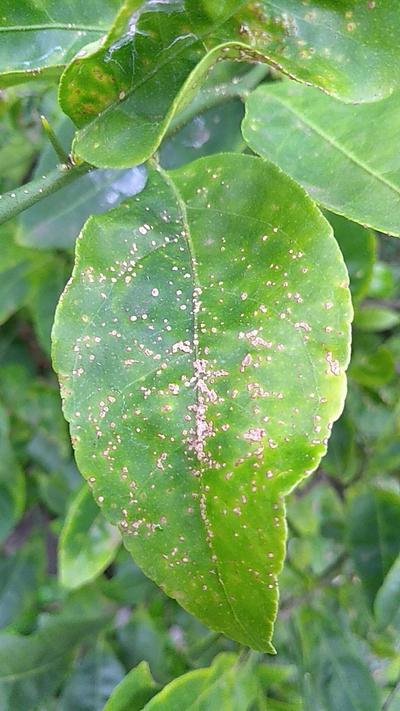Citrus Scab
Elsinoe fawcettii
Fungus
In a Nutshell
- Brightly-colored pustules.
- Later conical deformations with brownish tops.
- Distorted, wrinkled, puckered leaves with ragged margins.
- Fruits, twigs, shoots and stems can also be affected.
- Stunted and bushy growth.
Can also be found in
Symptoms
Symptoms vary slightly depending on the tree varieties and the environmental conditions. Usually, minute water-soaked spots appear first on young leaves. They later develop into creamy-yellowish or brightly-colored pustules on both sides of these leaves. As the disease progresses, these pustules evolve into irregular, conical deformations with brownish, velvety tops, which can cover a large part of the lamina. Old lesions have a scabby top and a rough appearance with cracks and fissures. Affected leaves become distorted, wrinkled or puckered, with ragged margins. Young twigs, tender shoots and stems can also show same symptoms. Stunted and bushy growth are two common features. During severe infections, defoliation often ensues. On fruits, these pustules are slightly raised and pink to light brown in color. As they mature, they develop into densely-packed wart-like scabs that turn yellowish brown or gray in color.
Recommendations

Organic Control
No biological treatment is available against these fungi. Certified organic fungicides based on copper can be used to prevent new infections and fungal spread. Care should be taken because copper can be toxic if not used correctly.

Chemical Control
Always consider an integrated approach with preventive measures together with biological treatments if available. Protectant fungicides based thiram, difenoconazole and chlorothalonil can be used preventively to avoid a widespread infection. Systemic fungicides are another option. Fungicide-tolerant strains of the pathogen have been found.
What caused it?
The symptoms are caused by the fungi Elsinoe fawcettii and E. australis, which cause similar symptoms in different varieties of citrus tree. Lemons, grapefruits, mandarins are susceptible to both. Elsinoe fawcettii infects mainly sour oranges and only some varieties of sweet orange. By contrast, E. australis causes sweet orange and lime scab but does not have sour oranges as hosts. The pink to brown color on top of the conical formations on leaves and the fruit wart-like structures are spores that are dispersed by rain splashes, dew, wind or overhead irrigation. Of the two citrus scab pathogens, E. fawcettii is the more widespread but E. australis is more economically significant as it attacks species of citrus which areaffect more widely grown.
Preventive Measures
- Be aware of the possible quarantine regulations in some countries.
- Use planting material from a certified source.
- Choose resistant varieties, if available.
- Intercrop with non-citrus trees such as avocado or papaya.
- Clear the field and surroundings of weeds.
- Do not transport suspected diseased trees to other fields or farms.
- Do not water with overhead irrigation.
- Keep the orchard clean of old branches, twigs and fruits.
- Prune to increase air circulation in the canopy.



